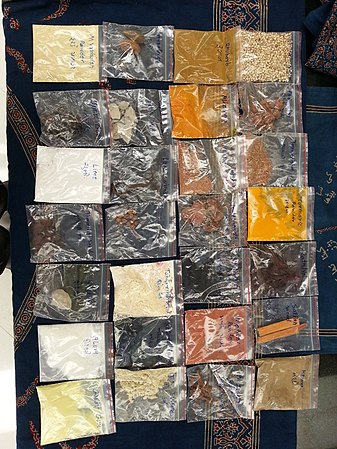
Screen printing is a printing technique where a mesh is used to transfer ink onto a substrate, except in areas made impermeable to the ink by a blocking stencil. A blade or squeegee is moved across the screen to fill the open mesh apertures with ink, and a reverse stroke then causes the screen to touch the substrate momentarily along a line of contact. This causes the ink to wet the substrate and be pulled out of the mesh apertures as the screen springs back after the blade has passed. One colour is printed at a time, so several screens can be used to produce a multi-coloured image or design.

Bandhani is a type of tie-dye textile decorated by plucking the cloth with the fingernails into many tiny bindings that form a figurative design. Today, most Bandhani making centers are situated in Gujarat, Rajasthan, Sindh, Punjab region and in Tamil Nadu where it is known as Sungudi. It is known as chunri in Pakistan. Earliest evidence of Bandhani dates back to Indus Valley civilization where dyeing was done as early as 4000 B.C. The earliest example of the most pervasive type of Bandhani dots can be seen in the 6th century paintings depicting the life of Buddha found on the wall of Cave at Ajanta. Bandhani is also known as Bandhej Saree, Bandhni, Piliya, and Chungidi in Tamil and regional dialects. Other tying techniques include Mothra, Ekdali and Shikari depending on the manner in which the cloth is tied. The final products are known with various names including Khombi, Ghar Chola, Patori and Chandrokhani.

Textile printing is the process of applying color to fabric in definite patterns or designs. In properly printed fabrics the colour is bonded with the fibre, so as to resist washing and friction. Textile printing is related to dyeing but in dyeing properly the whole fabric is uniformly covered with one colour, whereas in printing one or more colours are applied to it in certain parts only, and in sharply defined patterns.
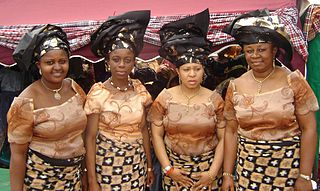
The wrapper, lappa, or pagne is a colorful garment widely worn in West Africa by both men and women. It has formal and informal versions and varies from simple draped clothing to fully tailored ensembles. The formality of the wrapper depends on the fabric used to create or design it.
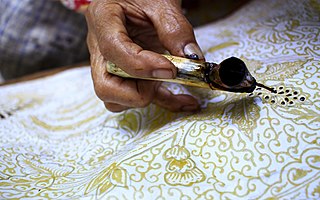
Resist dyeing (resist-dyeing) is a traditional method of dyeing textiles with patterns. Methods are used to "resist" or prevent the dye from reaching all the cloth, thereby creating a pattern and ground. The most common forms use wax, some type of paste made from starch or mud, or a mechanical resist that manipulates the cloth such as tying or stitching. Another form of resist involves using a dye containing a chemical agent that will repel another type of dye printed over the top. The best-known varieties today include tie-dye, batik, and ikat.
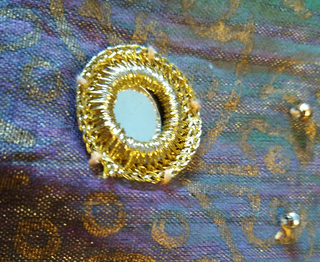
Shisheh, Kawan jo kam or abhla bharat embroidery, or mirror-work, is a type of embroidery which attaches small pieces of mirrors or reflective metal to fabric. Mirror embroidery is common throughout Asia, and today can be found in the traditional embroidery of the Indian subcontinent, Afghanistan, China, and Indonesia.
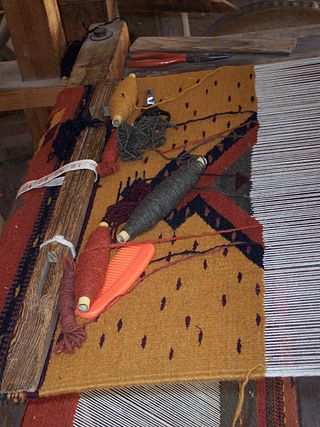
The state of Oaxaca in southern Mexico has a noteworthy tradition of finely crafted textiles, particularly handmade embroidery and woven goods that frequently use a backstrap loom. Oaxaca is home to several different groups of indigenous peoples, each of which has a distinctive textile tradition.
Pakistani clothing refers to the ethnic clothing that is typically worn by people in the country of Pakistan and by Pakistanis. Pakistani clothes express the culture of Pakistan, the demographics of Pakistan, and cultures from Punjab, Sindh, Balochistan, Khyber Pakhtunkhwa, Gilgit-Baltistan, and Kashmir regions of the country. The clothing in each region and culture of Pakistan reflect weather conditions, way of living, the textiles and embroidery used and its distinctive style which gives it a unique identity among all cultures.
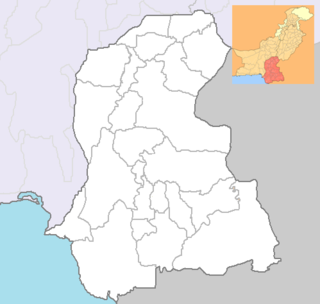
The Culture of Sindh has its roots in the Indus Valley civilization. Sindh has been shaped by the largely desert region, the natural resources it has available, and continuous foreign influence. The Indus or Sindhu River, which passes through the land, and the Arabian Sea also supported the seafaring traditions among the local people. The local climate also reflects why the Sindhis have a language, folklore, traditions, customs, and lifestyle that are so different from the neighbouring regions. The Sindhi culture is also practised by the Sindhi diaspora.
Digital textile printing is described as any ink jet based method of printing colorants onto fabric. Most notably, digital textile printing is referred to when identifying either printing smaller designs onto garments and printing larger designs onto large format rolls of textile. The latter is a growing trend in visual communication, where advertisement and corporate branding is printed onto polyester media. Examples are: flags, banners, signs, retail graphics.

The Sindhi cap, locally called Sindhī ṭopī rarely known as the Sindhi Kufi, is a skullcap worn predominantly by Sindhis in Sindh, Pakistan. Together with Ajrak, the Sindhi cap is regarded as an essential part of Sindhi culture.
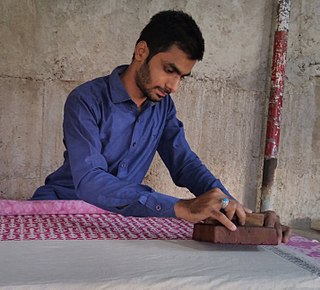
The crafts of India are diverse, rich in history, culture and religion. The craft of each state in India reflect the influence of different empires. Throughout centuries, crafts have been embedded as a culture and tradition within rural communities.

Sindhi clothing are a part of the Sindhi culture. Sindhi women and men wear the Shalwar Qameez or the Kurta with Pyjama. Women also wear Sari or ghagra. However, before the adoption of the Shalwar kameez, kurta, the Sari as well as other articles of clothing, Sindhis had their own traditional costumes.

Bagh print is a traditional Indian handicraft originating in Bagh, Dhar district of Madhya Pradesh, India. The process is characterised by hand printed wood block relief prints with naturally sourced pigments and dyes. Bagh print motifs are typically geometric, paisley, or floral compositions design, dyed with vegetable colours of red and black over a white background, and is a popular textile printing product. Its name is derived from the village Bagh located on the banks of the Bagh River.

Sajarak also known as Saraiki ajrak is a form of block-printing, inspired by the Sindhi Ajrak, found in South Punjab in Pakistan. It has become a symbol of the Saraiki culture and traditions.

Sindhi Cultural Day is a popular Sindhi cultural festival. It is celebrated with traditional enthusiasm to highlight the centuries-old rich culture of Sindh. The day is celebrated each year in the first week of December on the Sunday. It's widely celebrated all over Sindh, and amongst the Sindhi diaspora population around the world. Sindhis celebrate this day to demonstrate the peaceful identity of Sindhi culture and acquire the attention of the world towards their rich heritage.

Sussi or susi is a term for multicolored striped or checked cloth produced mainly in Sindh. Sussi is thin handloom fabric made of cotton, silk, or a blend of the two, with colored warp stripes. Sindh region was known for its production and exports during the Mughal period. Sussi was most often made with red and blue, blue and white, or green and white stripes, but other patterns were also produced. The fabric was exported to England, where sousaes were in great demand in the 18th century.

Sindhi embroidery comes from the arid province of Sindh in southern Pakistan, which has always been famed for its embroidery.
The crafts of Sindh and its craftsmen are held in high esteem and their works are notable not only in Sindh but also in many other places.
Block printing in India holds an important part in the country's rich cultural heritage and artistic traditions. Dating back thousands of years, this special ancient technique of textile decoration involves the meticulous carving of intricate designs onto wooden blocks, which are then dipped in natural dyes and stamped onto fabric to create vibrant patterns and motifs. This was a creative outlet for many.






